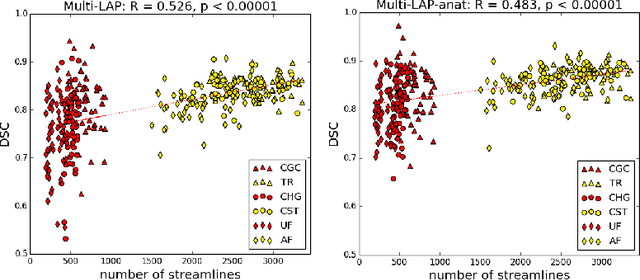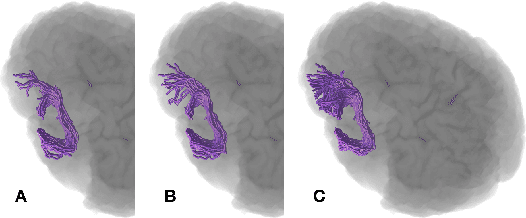Giulia Bertò
Anatomically-Informed Multiple Linear Assignment Problems for White Matter Bundle Segmentation
Jul 16, 2019


Abstract:Segmenting white matter bundles from human tractograms is a task of interest for several applications. Current methods for bundle segmentation consider either only prior knowledge about the relative anatomical position of a bundle, or only its geometrical properties. Our aim is to improve the results of segmentation by proposing a method that takes into account information about both the underlying anatomy and the geometry of bundles at the same time. To achieve this goal, we extend a state-of-the-art example-based method based on the Linear Assignment Problem (LAP) by including prior anatomical information within the optimization process. The proposed method shows a significant improvement with respect to the original method, in particular on small bundles.
Comparison of Distances for Supervised Segmentation of White Matter Tractography
Aug 04, 2017


Abstract:Tractograms are mathematical representations of the main paths of axons within the white matter of the brain, from diffusion MRI data. Such representations are in the form of polylines, called streamlines, and one streamline approximates the common path of tens of thousands of axons. The analysis of tractograms is a task of interest in multiple fields, like neurosurgery and neurology. A basic building block of many pipelines of analysis is the definition of a distance function between streamlines. Multiple distance functions have been proposed in the literature, and different authors use different distances, usually without a specific reason other than invoking the "common practice". To this end, in this work we want to test such common practices, in order to obtain factual reasons for choosing one distance over another. For these reasons, in this work we compare many streamline distance functions available in the literature. We focus on the common task of automatic bundle segmentation and we adopt the recent approach of supervised segmentation from expert-based examples. Using the HCP dataset, we compare several distances obtaining guidelines on the choice of which distance function one should use for supervised bundle segmentation.
 Add to Chrome
Add to Chrome Add to Firefox
Add to Firefox Add to Edge
Add to Edge